
VIDA Class Digs Deep Into Food/Nutrition
January 22nd, 2019
Making a connection between the classroom and real work issues that affect students’ daily lives has become a valuable resource for learning and teaching. So when a Design Challenge class at VIDA (Vista Innovation and Design Academy) wanted to lead students into a deeper exploration of issues around food and nutrition, we were thrilled to be asked to be part of that.
The Design Challenge class at VIDA sees students self-select topics presented to them by teachers, and then utilize minimum days throughout the year to learn about their chosen topic, identify a problem or challenge to solve, and then prototype and offer solutions to address the challenge.
I just wanted to make a difference and help people that need help to know what’s in their food and know what they’re eating.
Koby Tran, VIDA 8th Grader / Design Challenge Class Student
Why Explore Food?
The food and nutrition group is led by teacher David Ruiz, who explains his interest in the topic. “I like to consider myself somewhat of a foodie, not extreme, but I like exploring and trying different types of food and try to be healthy as much as possible. When I heard that [WaveCrest Cafe] was trying to wrap itself around a project and what kids thought about it, I thought it could be a cool opportunity to merge my interest in health/nutrition and food with that and explore cafeteria food and how does it factor in to kids’ perceptions of food and the choices they make.”
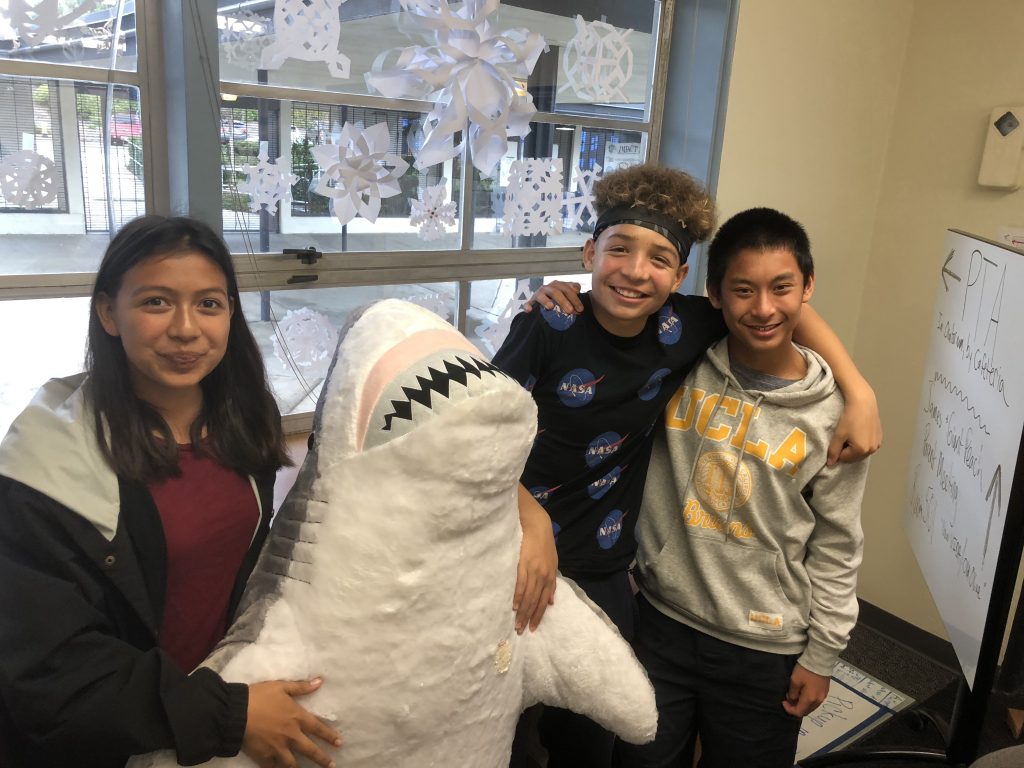
While Mr. Ruiz explains his desire to explore the topic, several of his students, all 8th graders, shared some of their interests and motivations. Said Samantha Larios, “For me, it was having people take food for granted. My mom’s always like, ‘don’t waste your food. When I was younger, when I was your age, I didn’t have these things.’ So that’s what made me choose this topic.”
For classmates Keelan Kung-Rosario and Koby Tran, the exploration also had personal significance. Says Keelan, “I chose this because [in] our modern day society, most of us eat a lot of fast food, and that a lot of people get, like, several of my family members have diabetes, and also people have been more obese lately.” Koby echoed that, “I know a lot of kids and some of my friends are a little overweight. I just wanted to make a difference and help people that need help to like, know what’s in their food and know what they’re eating.”
Mr. Ruiz’s classes started their process in the fall with two separate days of exploration on the topic.
Day One: The Central Kitchen
On the first, students were given a tour of the district’s Central Kitchen by Amy Haessly, the district’s Nutrition Education & Training Supervisor and a Registered Dietitian. They learned how the district prepares 20,000+ meals each day, including breakfast, lunch, and supper, seeing kitchen equipment, storage facilities, and the methods of distributing meals to schools. They saw how the facility runs like clockwork to ensure that meals are delivered as quickly and freshly as possible, staggering preparation and delivery times for each school site.
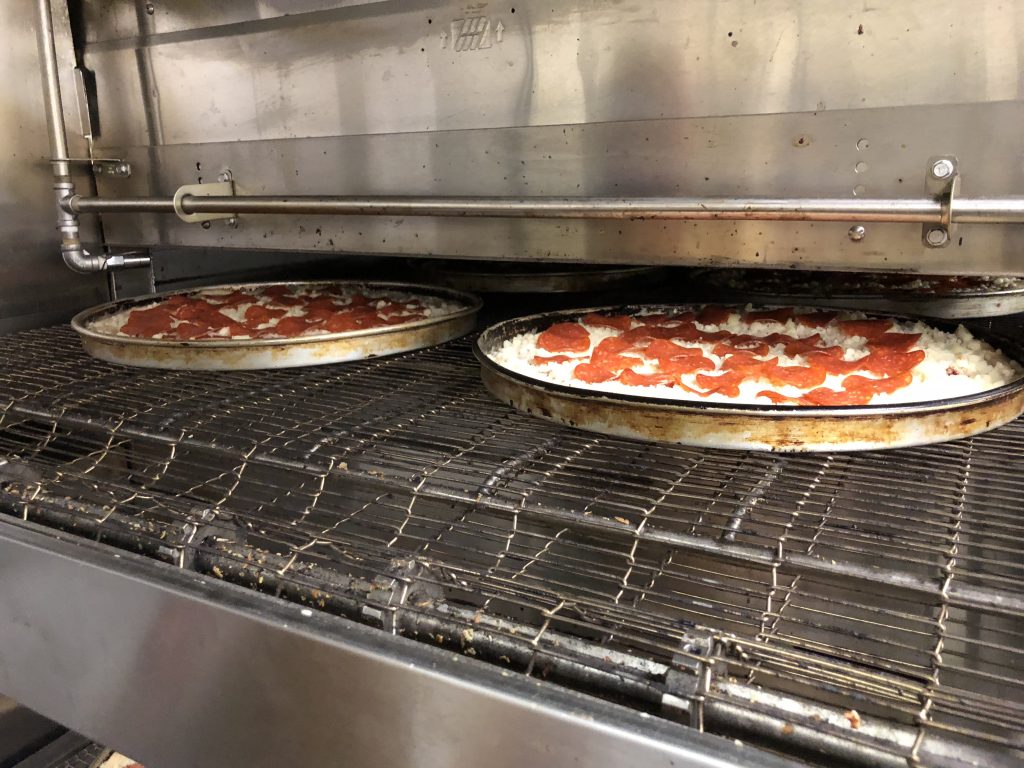
The front end of the commercial pizza oven. 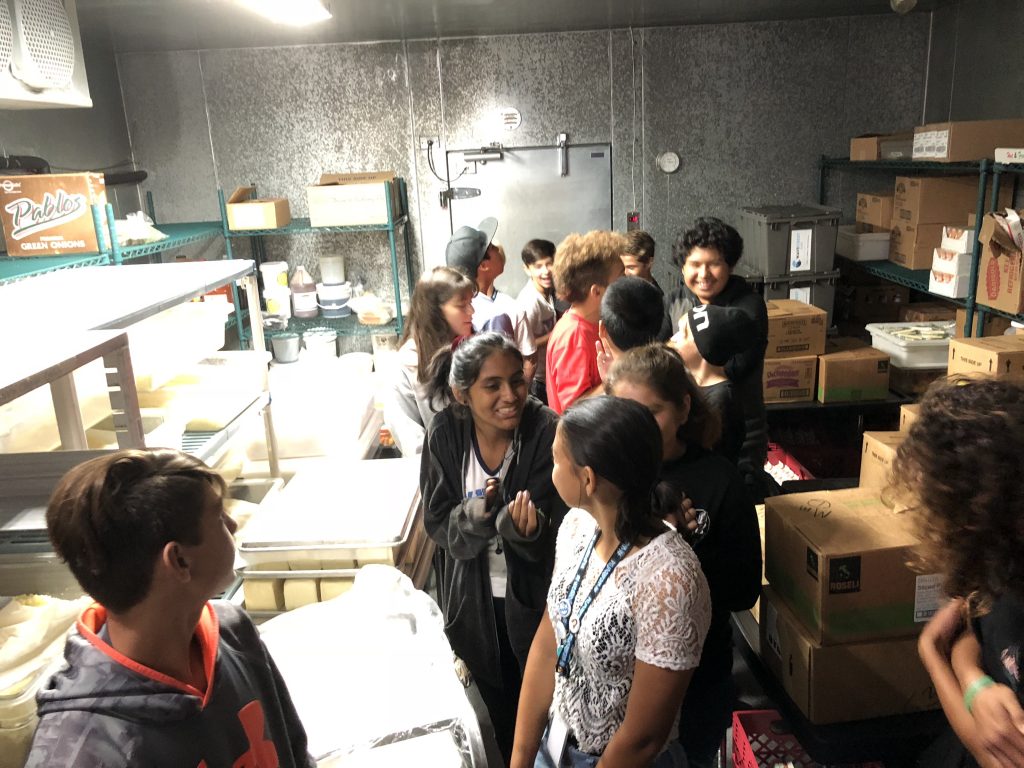
The group got a taste of the cold in a small walk-in freezer that stores several items. 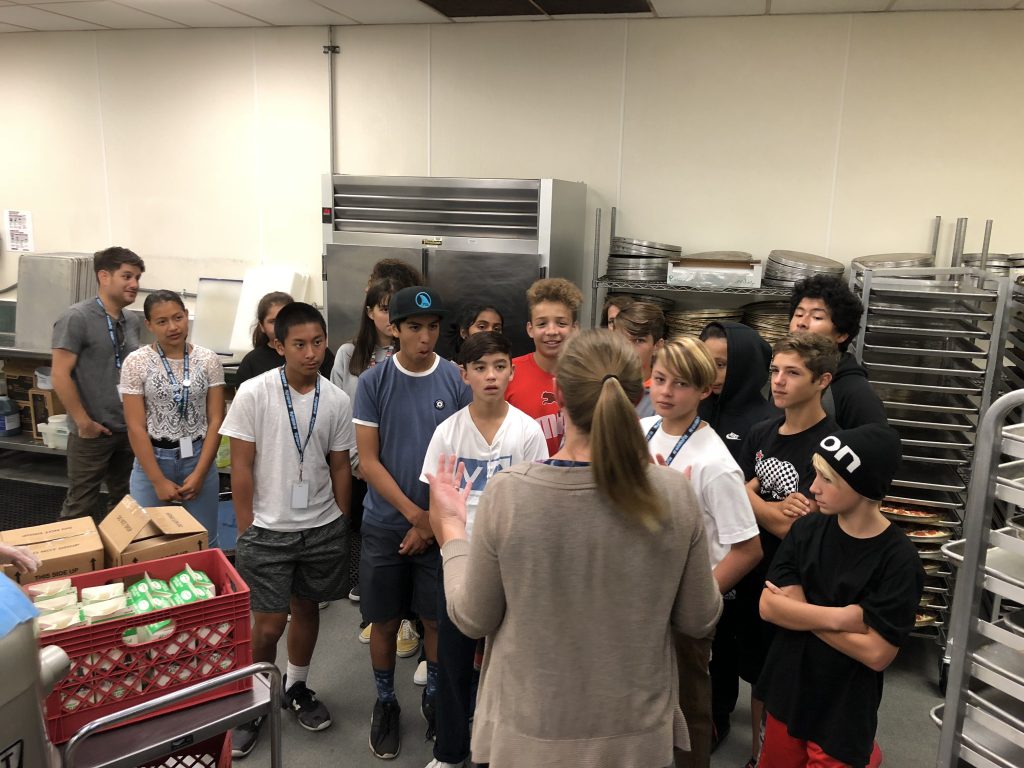
VIDA students begin their tour seeing how 300+ pizzas are made fresh daily.
Mrs. Haessly also spoke a bit about the ways that WaveCrest Cafe sources foods, working with dozens of small farms across the state of California, many within a short drive from Vista, as well as working with food distributors to provide the highest quality products. She also shared information about USDA guidelines that ensure that meals are protein-rich, low in saturated fats and sodium, and featuring whole grains.
Students were captivated by the commercial pizza oven that bakes over 300 WaveCrest Pizzas each day, and mesmerized by the drive-in freezer kept at a brisk 0 degrees.
After a tour, students gathered for a meal that sampled several WaveCrest Cafe menu items, as well as a conversation about what they had seen and experienced. Mr. Ruiz started the conversation by asking students, “what blew your mind about what you just experienced?” Said student Samantha Larios, “The time and the dedication that it takes to make meals for everybody, and that not everybody appreciates how hard people work for them.”
Said classmate Keelan Kung-Rosario, “People take so much time. It takes a long time to make the food, and some kids don’t even appreciate what people do for them. Which that’s kind of modern society, how kids take stuff for granted a lot. but I feel like if someone takes the time out of the day to give you food, you should take it.”
Mr. Ruiz also spoke of the thoughtfulness of the WaveCrest Cafe team. “I have been really struck by the level of care and attention that the WaveCrest team undergoes to try to make the best possible food for our kids and for us. It’s not like they’re just going through the motions and putting slop on our plates – there’s a lot of thought that goes into it. and a lot of consideration. That in and of itself just blew my mind.”
“I have been really struck by the level of care and attention that the WaveCrest team undergoes to try to make the best possible food for our kids and for us.”
David Ruiz, VIDA Teacher
Day Two: How Do They Do That?
A few days after the tour, Mrs. Haessly led off a two-part classroom experience by sharing a wealth of information about how WaveCrest Cafe operates. She shared USDA guidelines and how planning a menu involves making sure that meals conform to these federal nutrition regulations. She also laid out the process of adhering to a budget, showing students just how much money from each meal is allocated to areas including: the food itself; labor/paying employees; facilities; transportation; etc.
Students and staff alike were amazed to see just how far the department was stretching its funds to deliver the best product possible. Said Mr. Ruiz in reflection, “Trying to do this with such a limited budget is mind-boggling. It’s almost being a miracle worker to serve food given the amount they have to spend on ingredients, let alone labor, expenses, etc. That just seems like a monumental task. I know I couldn’t do what they do on a budget for my own home.”
Day Two: Taste Test
After processing how WaveCrest Cafe runs, the students took their newly gained knowledge and hosted a taste test in a classroom. The event featured several menu items from the current winter menu, including a Pork Bahn Mi sandwich, a meatball sandwich, a turkey cranberry wrap, and fresh persimmons from the Harvest Of The Month program. They invited students from all three grade levels at the school, as well as teachers and staff, to get a cross section of responses to represent the school’s population. The Design Challenge class’s students staffed each station, explaining each item and recording feedback and impressions.
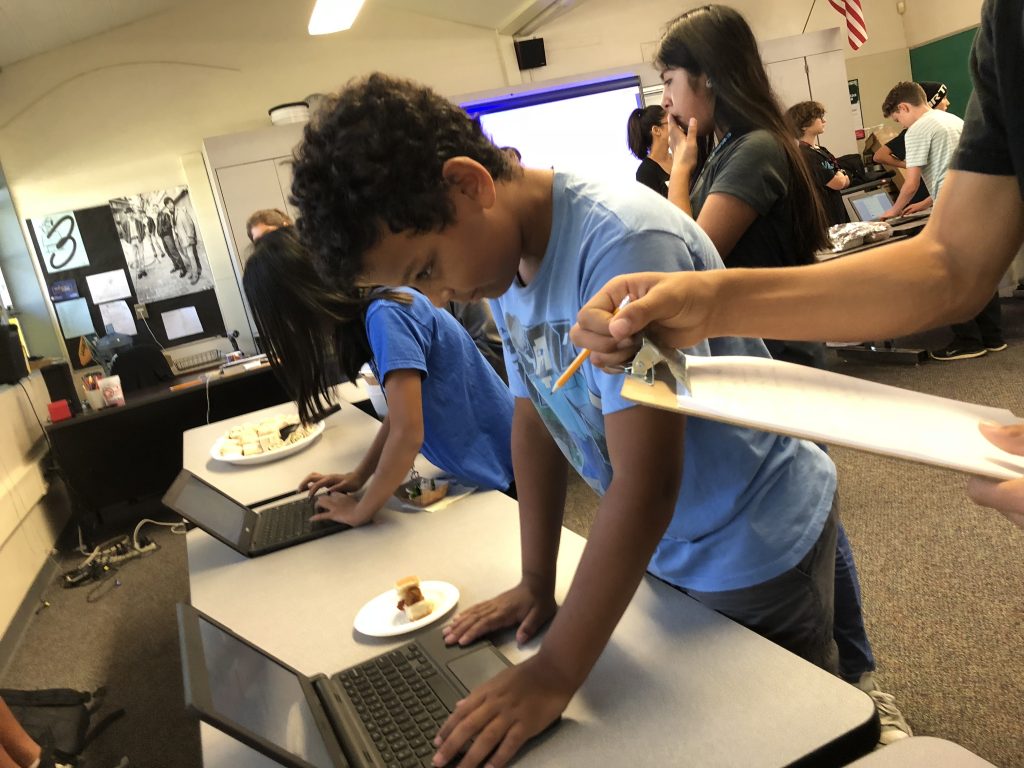
As students sampled foods, classmates were on hand to collect feedback for review. 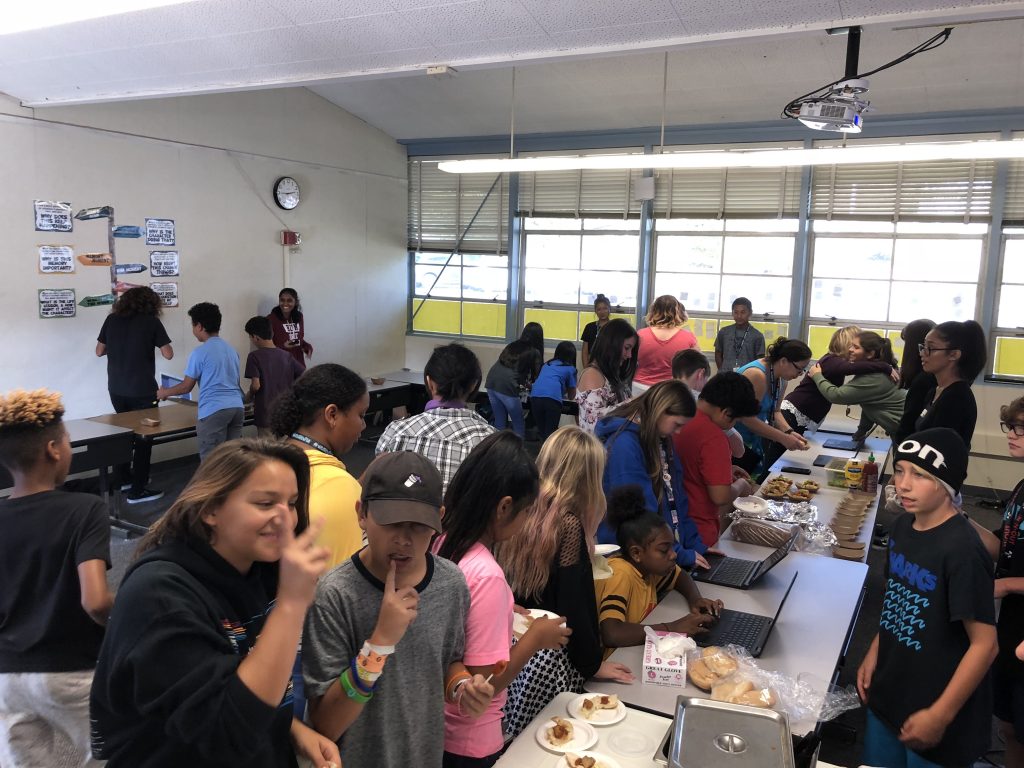
6th, 7th and 8th graders, as well as teachers and staff gathered for a taste test run by the Design Challenge students.
Said Keelan, “the kids loved the new food. Everyone loved the food, how fresh it was, and then they were like, ‘but cafeteria food’s supposed to be bad!’ or something, but it was actually good and everyone had a good reaction to it.”
Keelan’s classmate Koby Tran saw a slightly different response from his vantage point. “They all liked the meatball sandwich – that was their favorite. But when they went to persimmon, they skipped it. they didn’t even try it.”
What Affects Food Choices?
This spurred a conversation about why different foods are or aren’t tried, and how to encourage students to try new foods and maybe even find new favorites. Keelan offered his observation. “I think that if kids nowadays see a vegetable or a fruit, they’re like, ‘eww, what’s that? I want a burger or pizza or meatballs and spaghetti instead of having their fruits and veggies.’ Probably because there’s more ads for fast food than there is for healthy food.
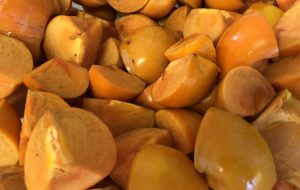
Added Koby, “When a person watches an ad, since they’re always on 8 hours a day watching an ad. When they see a good deal, it’s not that they don’t want the fruit, I think it’s just, ‘this is a better deal.’ For example, I saw this Sonic thing for like 3 bucks you get 2 burgers and some tater tots or something. It’s like, they’re making it a deal. Whereas you don’t see that much healthy stuff on there for a deal for fast food.”
The three students each spoke of a new food or food item that they have tried recently to identify how food tastes and preferences can and do change throughout life.
Where Do We Go From Here?
The Design Challenge class will now take the information they’ve researched and their experiences they’ve had and formulate their next steps. Each student will be asked to identify a problem or challenge, and then begin to design and propose a solution for the challenge.
Mr. Ruiz explains the process: “Their eyes are open and I think they’re much more empathetic now, as am I, to the people who are making this food and overcoming the negative stereotypes [of school food]. Now the question is, what can they do? They now understand several sides: the kid perspective, the consumer perspective, and the producer perspective. And I’m not even sure which side of that we’re going to tackle – that’s what they have to figure out.”
For Keelan, his statement about fast food advertising hints at something that he has learned through the process. ” I saw a video that Mr. Ruiz sent about how fast food companies are attacking teens, and certain kinds of ethnicities, and I’m tackling that issue.” Says Samantha, “I want to dive deeper into the minds of teens [related to food.]’
Says Mr. Ruiz about this approach to learning. “I think learning through experience is one of the most powerful ways to learn. What we’ve done already has been pretty invaluable. And in the end, even if they don’t come up with the silver bullet that’s going to make everyone love cafeteria food while being healthy, as long as they had a really powerful learning experience, then that validates the entire learning experience. If they can walk away from this school year and say, ‘I understand this complex issue of child nutrition and I understand how it’s impacting our country and I understand how a district like Vista tries to tackle it,’ that’s where our efforts as a teacher – it’s where I get my validation for my efforts. If you can talk about an issue in an intelligent way and have some ideas about how to approach it, then that’s good enough.”
That, and perhaps finding some delicious new favorite foods.
Stay tuned to the WaveCrest Cafe website and social media channels for more updates on the VIDA Design Challenge class and their exploration of this topic.
